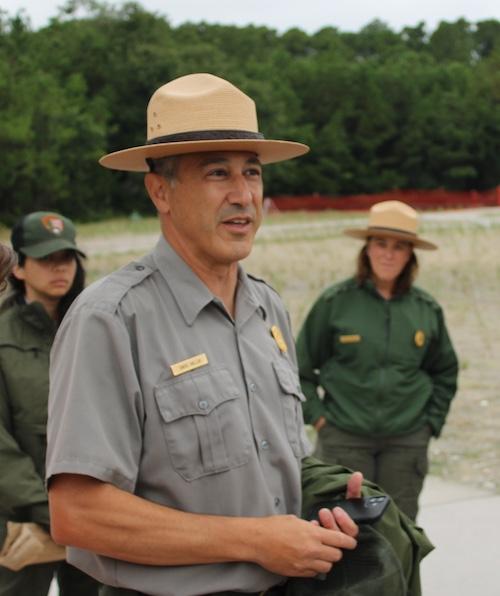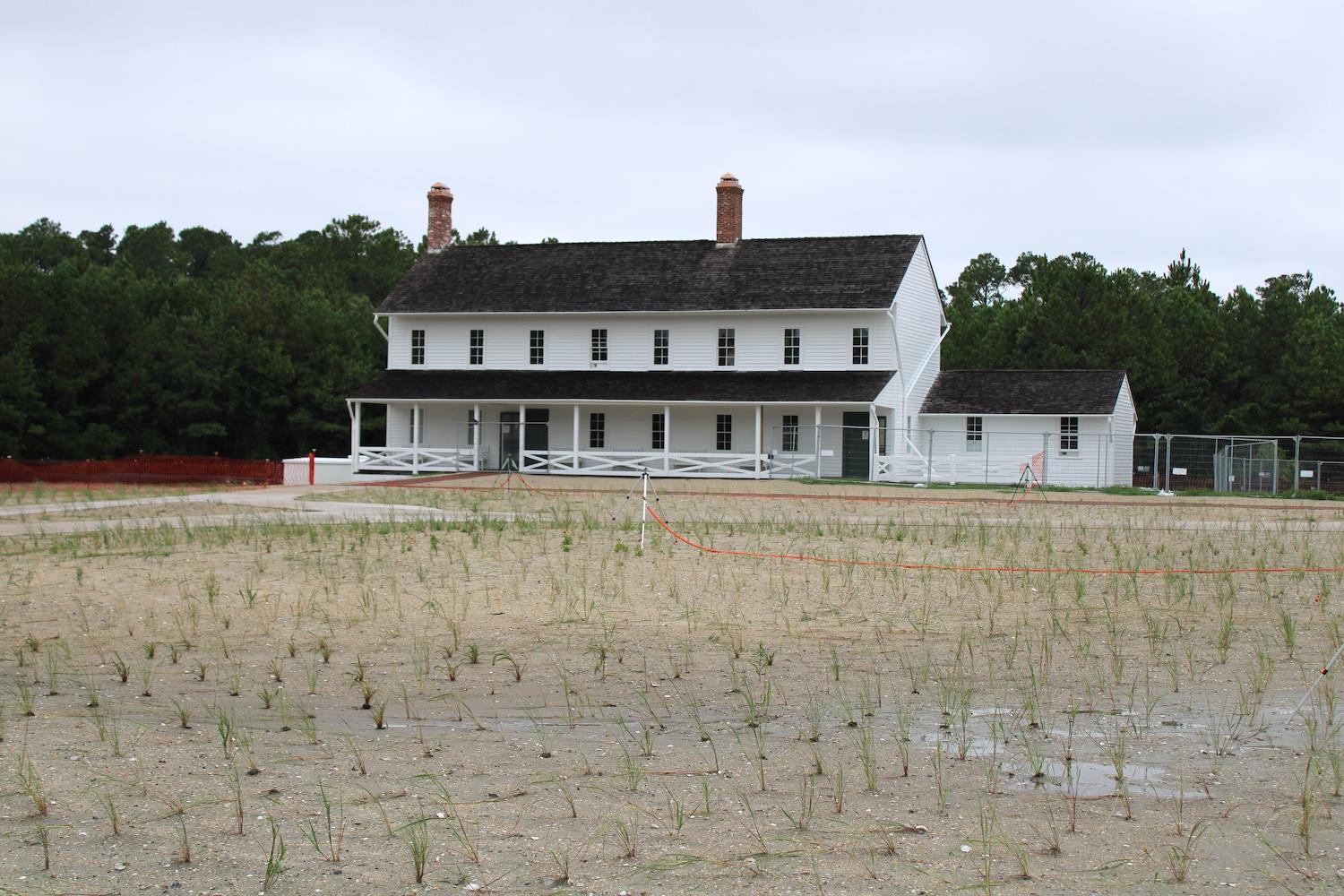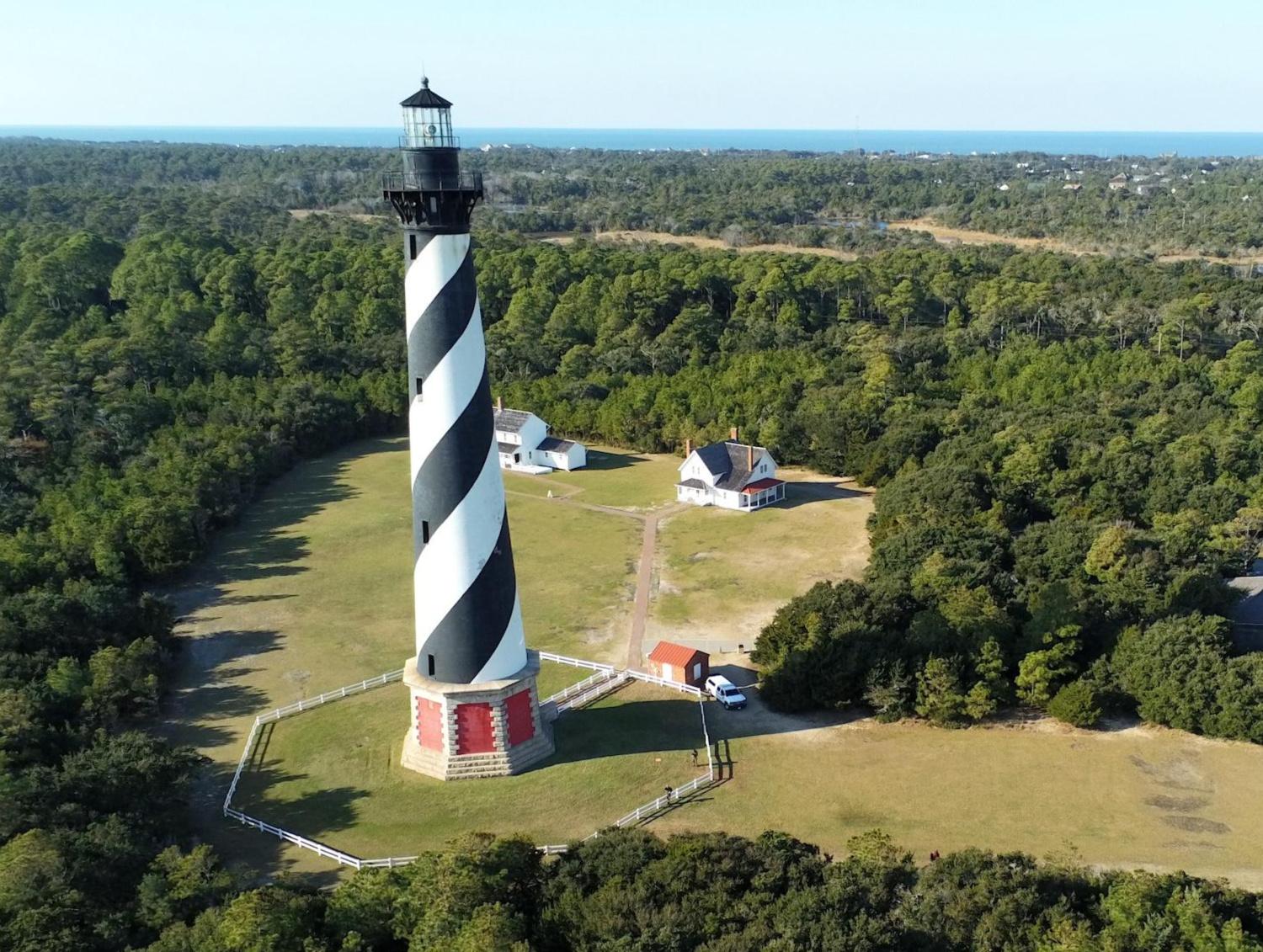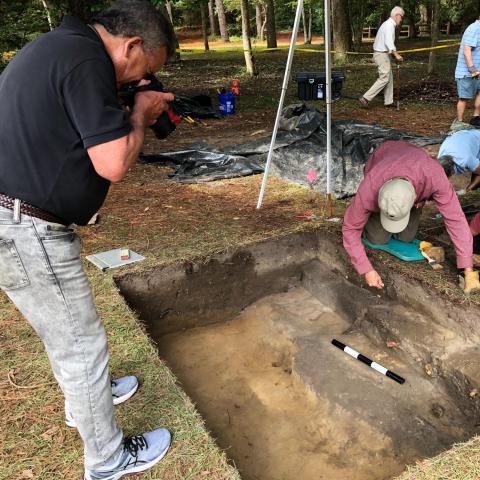Editors note: This summer, the National Parks Traveler is taking a close look at Cape Hatteras National Seashore, which is grappling with serious issues related to its beaches, wildlife, and historic structures. This is the first of three articles.
On a blustery July morning, a park ranger pushed open a section of chain-link fencing at Cape Hatteras National Seashore and invited me and a group of visitors to step inside. Just over the dunes, steady winds up to 20 miles per hour pushed endless whitecaps towards the shoreline. The overnight rain had stopped, but clouds swirled overhead. At the center of it all stood the Cape Hatteras Lighthouse, towering over this windswept landscape as it has for nearly 155 years.
There was one major difference, however: The lighthouse was completely shrouded in scaffolding, looking more like an Apollo-era Saturn 5 rocket next to its launch tower than the tallest lighthouse in North America. Beneath all the metal framing, the lighthouse’s black-and-white, barber-pole daymark—as a lighthouse’s distinct paint job is called—was largely obscured.

Superintendent Dave Hallac explained the work being done to restore the lighthouse/Declan McCleaf
The scaffolding is the most obvious evidence of a $19.2 million restoration of the lighthouse that has been under way in earnest for the past six months, after being announced last year. The goal of the far-reaching restoration is to bring the lighthouse back to its original appearance, while ensuring that the structure and its surroundings can better withstand the site’s sometimes-punishing environmental conditions. Led by project managers Stone and Lime Historic Restoration Services out of North Brookfield, Massachusetts, the work includes removal, repair, and replacement of deteriorated bricks and metalwork, stripping of old paint and installation of new exterior coating, and the highly anticipated installation of a replica Fresnel lens.
This is the latest major effort to protect the light station, one of the most beloved park structures in the country. At just over 198 feet tall, the lighthouse has stood sentinel over North Carolina’s Outer Banks—an ever-shifting strand of barrier islands that is a perennial beach destination—since 1870, long before Cape Hatteras became part of the national park system in 1953. In 1999, NPS famously moved the lighthouse 2,900 feet inland, to protect it from a constantly encroaching shoreline as the barrier island shifted westward.
This current restoration has a similar aim to extend the iconic structure’s longevity, especially in the face of climate change and worsening storms. “Our goal is to make the lighthouse as resilient and as resistant to this environment as possible,” Eastern Parks of North Carolina Superintendent David Hallac told the group. “It’s peppered with salt spray, exposed to high winds. Where we have the opportunity to use more resistant materials and materials that are noncorrosive, we hope we’ll get as much longevity [at the lighthouse] as we can.”
A New Coat And New Materials
In February of this year, the Lanham, Maryland-based company Scaffold Resource brought in 25 truckloads of scaffolding so workers could begin the immense effort to build a temporary exterior skeleton around the lighthouse. By summer, the restoration had moved into a highly active phase. On the day our group visited, workers were preparing to remove all the exterior paint from the lighthouse, according to Lindsey Gravel, project manager with Stone and Lime, and to replace it with Keim mineral coating, a paint that chemically bonds with brick in a way that is protective but does not allow water to be trapped inside the brick. Keim coatings are known for being resistant to weathering and UV light and offer highly stable coloring, reducing future maintenance needs. And protecting the brick is paramount: The current restoration includes replacing 30,000 to 40,000 failing bricks out of the 1.25 million bricks that make up the Hatteras light, Gravel says.
One noticeable change will be the color of the base of the lighthouse, which has evolved over the decades to a pinkish-red. The base color “has been a huge conversation for us,” Gravel says. “We want to bring it back to what it used to be around 1873, which was more of a darker red, like a brick red. So we're working on that. We have a couple of selections that we're talking about internally. That will generate some conversation.”

Cape Hatteras Light late in 2020/NPS
Other work includes replacing long-absent architectural features such as the original iron pediments over the windows, wooden doors, and iron fencing.
In another highly noticeable change, the patchy grass lawn that had once stood between the lighthouse and the lightkeeper’s quarters, a historic building long used as a museum, has now been replaced with between 1,200 and 1,500 new plants, designed to better replicate historic vegetation on the site. On the day I visited, clumps of sea oats, switchgrass, and spartina sprouted from the sandy soil in endless rows, reminding me of a little bit of new hair plugs. Before long, these tall grasses will grow and fill in, protecting against erosion and providing a more ecologically sound and historically accurate native habitat.
“The whole idea was to recreate more of a native assemblage of vegetation like you’d see in the back dune area when the lighthouse was built,” Hallac says.
New paved walkways offer improved circulation routes for visitors and will help protect the vegetation once it grows in as well.

Revegetation of the lighthouse grounds/Declan McCleaf
The Park Service notes that the planned 18-month restoration allows for some lost time due to high winds and storms. “Twenty mile-per-hour winds on the ground feel like 50 miles per hour up on the structure,” Gravel says, something they track closely. If a hurricane were to bear down on Hatteras, the team is prepared to remove most of the scaffolding in a timely fashion.
Rebuilding The Lens
Despite everything happening at Cape Hatteras, one of the most anticipated aspects of the restoration is in progress 800 miles away in central Florida. Craftsman Dan Spinella, principal of Artworks Florida and a foremost expert on Fresnel lenses, is now crafting a nearly exact replica of the original first order Fresnel lens that once operated in the Hatteras lighthouse.
Named after its early 19th-century inventor, Augustin-Jean Fresnel (pronounced fruh-nel or fray-nel), these lenses represented a major step forward in lighthouse technology in that they relied on a series of concentric curved pieces of glass, or prisms, to reflect and refract light, focusing and extending its power and reach. Fresnel lenses were classified by their size and strength, with sixth order being the smallest and first order being the most powerful (smaller seventh and eighth order Fresnel lenses were not used in the United States). Rotating lenses were operated via a clockwork mechanism that required hand-cranking. The Fresnel lens has often been called “the invention that saved a million ships.”

Lantern room schematics/Dan Spinella
By the mid-20th century, the original Cape Hatteras lens had been damaged by vandals and had parts stolen before the remnants were finally placed into NPS storage. An electrified aerobeacon was used at the lighthouse until it was replaced with LED lighting in anticipation of the pending restoration. In 2002, the Park Service loaned the original lens to the Graveyard of the Atlantic Museum on southernmost tip of Hatteras Island; it was joined four years later by the original pedestal.
Today, Spinella is creating a first order lens for Hatteras that replicates the exact size and design of the original, including a clockwork mechanism and exactly 1,008 prisms. Instead of glass, however, the replica will use acrylic, which is lighter and more evenly transparent than glass, and the clockwork will merely be a visual, interpretive element. The lens will enclose a modern LED lamp made expressly for Fresnel lenses by the Sabik marine light company. The flash pattern will be the 10-second pattern that was used in 1870, visible for about 18 miles out to sea.
“I’m building from the ground up and redesigning as I build this thing,” Spinella says. “The whole design took me years. I’ve modernized the whole thing.”
Around the time the original lens pedestal was removed, Spinella was already wondering whether the lighthouse might ever want a replica Fresnel lens, so he went to the lighthouse and took measurements, long before the current restoration was scheduled. Over the years, he used computer modeling software and his engineering training to work out the exact dimensions of a modified Fresnel lens. He first built a prototype, which the Park Service or the Graveyard of the Atlantic Museum may put on display in the future.
As of this summer, Spinella has finished the lens cabinet and lower section of the lens pedestal, created the rotation assembly, and begun installing the prisms. It takes about an hour per prism to install in the lens frame, and at the time I talked to Spinella in early July, he had installed 16. (“Only 900 and something to go!” he said with a laugh.)
“Dan is a little bit ahead of schedule, so we have no fears of him being able to install the lens by the end of this project,” Gravel says. “We'll be able to use the scaffolding and the hoist to bring everything up and safely install each component.”
Expect many eyes to be on Hatteras when Spinella’s lens is installed sometime in spring 2025. The target completion date for the entire project is September 2025. Till then, the Cape Hatteras museum and visitor center remain open to visitors, and daily ranger programs will offer updates on the project’s progress.
“Cape Hatteras is the lighthouse I always wanted to do a lens for,” Spinella says. “It’s pretty exciting to be able to do a lens of this size, to the detail of the original, for the tallest and most recognized lighthouse in the United States. It’s something I’ve always wanted to do. As it gets further along into the process, I can see how well it’s going together.”




 Support Essential Coverage of Essential Places
Support Essential Coverage of Essential Places







Add comment